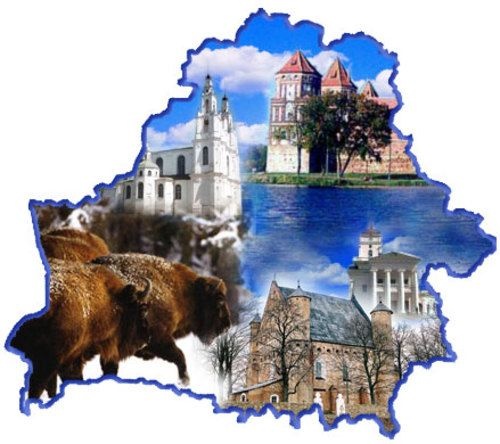
There are more than 4 thousand deposits of 30 types of minerals in the Republic of Belarus. Of particular importance are potassium salts, in deposits of which the country is among the leaders in Europe. The reserves at individual mines can be utilised another 20 to 115 years.
 The country is rich in non-ore materials: granites, dolomites and dolomite limestone, marl and chalk, fire-resistant and refractory clay, loam, sand-gravel compounds. The developed raw material base of these minerals meets the internal demand and gives hopes for the expansion of mining if there is favourable situation on the external markets.
The country is rich in non-ore materials: granites, dolomites and dolomite limestone, marl and chalk, fire-resistant and refractory clay, loam, sand-gravel compounds. The developed raw material base of these minerals meets the internal demand and gives hopes for the expansion of mining if there is favourable situation on the external markets.
Peat deposits in Belarus amount to 4.4 billion tons, of which 320 million tons are extracted annually.
Sapropel is a promising type of resources, the stock of which is estimated as 3 billion cubic m.
Belarus possesses a unique supply of mineral  drinkable and balneal waters.
drinkable and balneal waters.
Available in huge amounts mineral waters provide favourable conditions for setting up spas and sanatorium. Companies bottling and setting mineral medical and table waters can enjoy brisk demand for their product both within Belarus and abroad. 63 big springs were developed, which have a supply of 15,572 cubic m/day, whereas the actual daily intake does not exceed 900 cubic m.
Oil deposits are not great and oil is extracted in small quantities (maximum 2 min tons per year). There were also developed deposits of brown coal and shale. Only detailed exploration of the Brinevsk deposit of brown coal can ensure preparation to an industrial development of their stock of 30 min tons. In general, the amount of the fuel-power resources being extracted nowadays, including the accompanying gas and firewood, cover 12% of the total demand only.
 There are promising deposits, areas and spots where additional geological prospecting is required. They are deposits of ferrous ores, rare metals, aluminium and soda raw materials, combustible shale, phosphorites, coalines, gypsum, mineral fibres, bentonite clay, underground highly mineralised brines, areas looking promising with regards to diamonds, gold, amber.
There are promising deposits, areas and spots where additional geological prospecting is required. They are deposits of ferrous ores, rare metals, aluminium and soda raw materials, combustible shale, phosphorites, coalines, gypsum, mineral fibres, bentonite clay, underground highly mineralised brines, areas looking promising with regards to diamonds, gold, amber.
A comprehensive approach to the developed and perspective mineral deposits is a significant moment in the studies of depths. Gold nuggets, platinoids, silver in the acting sand and gravel pits, in potassium ores of the Starobin deposit, in the ferrous ores of the Okolovsk deposits, etc. have been found recently. The depths of Belarus have not been studied enough. The appearance of the up-to-date technologies requires the acceleration of the geological prospecting work.
 More than 20 thousand rivers of the total length of about 91 thousand km are flowing across the country. The rivers belong to the watersheds of the Black and Baltic seas. 6 rivers over 500 km (the Beresina, the Neman, the Pripyat, the Sozh, the West Dvina and the Dnieper) are also important as navigable rivers.
More than 20 thousand rivers of the total length of about 91 thousand km are flowing across the country. The rivers belong to the watersheds of the Black and Baltic seas. 6 rivers over 500 km (the Beresina, the Neman, the Pripyat, the Sozh, the West Dvina and the Dnieper) are also important as navigable rivers.
One of the peculiarities of the Belarus nature is a great number of lakes: about 11 thousand of the total area of about 2,000 sq. km. The total area of the glacial lakes is around 1,200 sq. km, flood-plain lakes — 800 sq. km.
Over 130 water reservoirs of the total area of 799 sq. km were built to control the ground waters and humidity of the adjacent lands. The whole territory of the country is covered by a drainage network, the total length of which amounts to 17,051 km, of which 9,095 km belong to the river Pripyat watershed.
 11 big fish-breeding facilities were built, having the total area of 173 sq. km (144 sq. km — fishing ponds of the area of 40 to 100 ha, and 29 square km — nursery ponds of the area of 20 ha).
11 big fish-breeding facilities were built, having the total area of 173 sq. km (144 sq. km — fishing ponds of the area of 40 to 100 ha, and 29 square km — nursery ponds of the area of 20 ha).
Resources of the surface and underground waters are fairly sufficient to meet the current and future demands in water: river water reserves amount to 57.9 cubic km (average many years’ standing outflow), the resources of the underground fresh water — 15.9 cubic km per year. The total amount of water accumulated in lakes is estimated as 6 to 7 square km, the reservoir water — 3.1 square km.
Water intake for consumer and economic needs does not normally exceed 5 to 7% of the annually renewed resources.
 Belarusian forests occupy about 36% of the country’s territory. Pre- mature, mature and over-mature forest amount to 19%. 1.3 cubic m of timber from 1 ha of the forest area are stockpiled in Belarus, compared to 5.4 in Germany and 3.7 in Austria.
Belarusian forests occupy about 36% of the country’s territory. Pre- mature, mature and over-mature forest amount to 19%. 1.3 cubic m of timber from 1 ha of the forest area are stockpiled in Belarus, compared to 5.4 in Germany and 3.7 in Austria.
Qualitative changes allowing an increase by 1.7 to 2 times of a cutting area by main use are expected by the year 2015. The volume of 5,427 thousand cubic m is a plan for 1999, which corresponds to the level of the five previous years. The total volume of the stockpiled liquid timber will make about 10,500 thousand cubic m. Approximately 12 million cubic m of timber can be stock-piled for all types of cuttings.
Our forests are rich in medical herbs. About 290 types of herbs important for the scientific and folk medicine can be found. Belarus is one of the countries exporting wild rosemary, fresh water sponge, bearberry, St. John’s wort, etc.
Since long, Belarusian forests have been a source of a high-quality soft resin. Potential tapping as of 1999 amounts to 30.1 thousand tons, whereas the actual out-take — 20.1 thousand tons. The forecast for 2005 is that this figure may double.
 General biological resources of mushrooms by main types account for 70.3 thousand tons, gross — 58.4 thousand tons. On average, about 2.3 thousand tons of mushrooms yearly have been procured for the recent 20 years. The population gather for their consumption 15 thousand tons. Biological resources of bilberry constitute 64.5 thousand tons, great bilberry — 10.3 thousand tons, red whortleberry — 5.8 thousand tons, cranberry — 14.1 thousand tons. The annual harvest of wild fruits and berries is estimated as minimum 36 thousand tons, whereas only 25% of this quantity is being actually gathered.
General biological resources of mushrooms by main types account for 70.3 thousand tons, gross — 58.4 thousand tons. On average, about 2.3 thousand tons of mushrooms yearly have been procured for the recent 20 years. The population gather for their consumption 15 thousand tons. Biological resources of bilberry constitute 64.5 thousand tons, great bilberry — 10.3 thousand tons, red whortleberry — 5.8 thousand tons, cranberry — 14.1 thousand tons. The annual harvest of wild fruits and berries is estimated as minimum 36 thousand tons, whereas only 25% of this quantity is being actually gathered.
Forest apiculture is an important type of forest utilisation. Honey output of the forestlands is estimated at 36 thousand tons including 27.2 thousand of environmentally safe resources.



